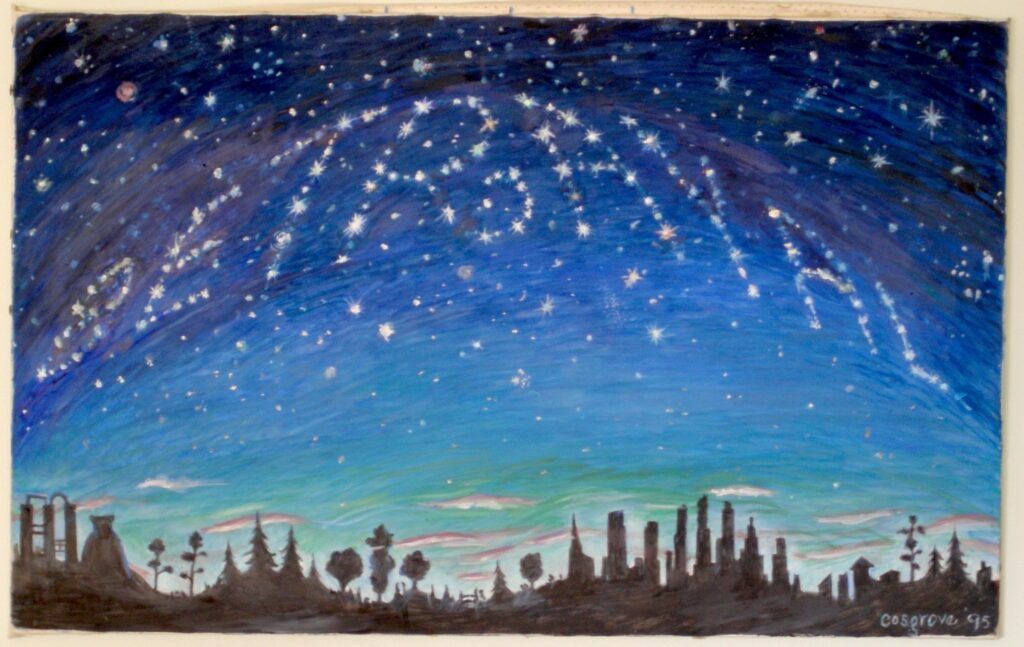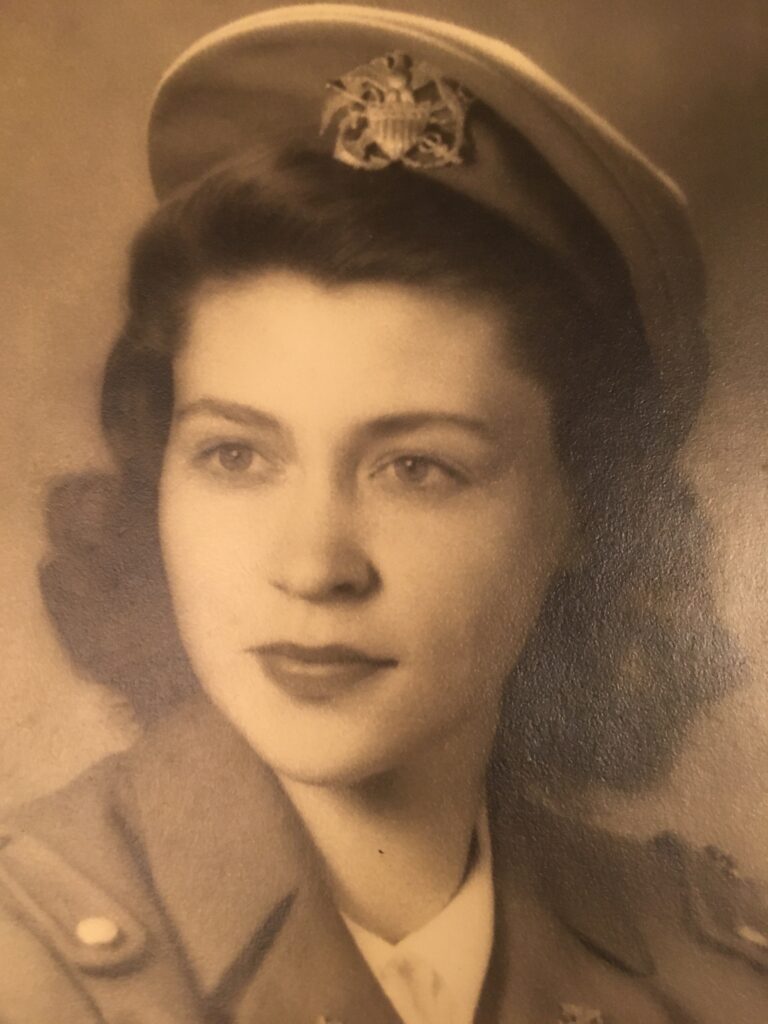More than just a trusty provider of cinematherapy, Turner Classic Movies is also an easily accessible chronicle of art history. Exhibit A: the day I passed by the TV and noticed a dapper gentleman, circa 1950s, speaking from his office at Metro-Goldwyn-Mayer—a Technicolor talking head, surrounded by framed artworks. He was Dore Schary, then head of MGM, and the family portraits behind him—of his three young children—were all created by Mrs. Schary, the artist Miriam Svet. Grabbing my iPhone, I pinch-zoomed the paintings; one depicts the entire Schary family, with the coverall clad artist standing by her easel, a latter-day Velazquez posed within her composition. (The coveralls, I later learned from her daughter, were made for Svet by the MGM costume department.)

Just as his talented wife commands her family portrait, Schary supportively placed himself in the motion picture frame so as not to obstruct our view of Svet’s paintings, while he showed off MGM’s forthcoming film attractions. Schary didn’t mention his wife or her work—that would’ve been a conflict, as his job was to discuss movies starring Ava Gardner, et al—yet the paintings quietly stole the show.
The couple’s eldest daughter, who appears in three of those paintings, is the acclaimed author Jill Schary Robinson. She writes: “I am lured by writers who write as if they consider the selection of every word, in the way my mother attended to the exact stroke of her paintbrush…” I’ve had the opportunity to examine, up close, Miriam Svet’s exquisitely exact brushwork: precise, horizontal strokes of oil paint aggregating like scales on some splendid sea creature. Those meticulous marks conjured, among many other subjects, the likeness of a bona fide American icon that now resides in the National Portrait Gallery of the Smithsonian Institution: Carl Sandburg, captured in 1962 with a palette referencing his wonderful poem, “Honey and Salt.”
Miriam Svet’s husband was a proponent of “message pictures”—movies that educate and inform as they entertain.”

Working on the opposite coast, in her NYC studio-within-a-studio-apartment, Margaret Cosgrove made message paintings that could double as set designs for the ultimate disaster film. That is, when she wasn’t authoring 10 instructional books for young readers, including A is for Anatomy (Lutterworth Press, 1965), or teaching art to students of the Spence School, this writer included. The great environmentalist Rachel Carson would have recognized in Cosgrove a kindred spirit; her surrealist scenes, calling to mind the work of Leonora Carrington, issue a very real warning about wanton waste destroying our fragile ecosystem.

Her paintings are sobering chronicles of planetary death foretold with an acutely Native American Indian prescience. Cosgrove was baptized in Sylvania, Ohio, with the middle name Leota, also her mother’s name; in Cherokee, Leota means beautiful blue flower. There are no flowers in Cosgrove’s painting titled LaNdscApe (undated); it’s almost impossible to see the dwindling forest for the invasive, industrial-strength electrical towers, rigs, and powerlines that multiply menacingly, while tree stumps bear sad witness; a leaden arch spells out a parting shot: U DIDN’T LISTEN. In Cosgrove’s cosmos, the imperiled earth and sea leave nowhere to look but up—where the midnight-blue sky reveals twinkling stars that spell out BETRAYAL. Cosgrove isn’t all gloom; Flight of Bats is her exalting, painterly tribute to this magnificent, mystical, misunderstood species.

Interesting, isn’t it, how two great artists could so easily slip through history’s cracks? Svet’s portrait of Carl Sandburg sits in storage at the Smithsonian, like most artwork held by museums, out of sight and mind. (Her family members treasure the paintings in their possession; Schary Robinson’s son, United Talent Agency CEO Jeremy Zimmer, proudly displays one in his office.)
Cosgrove’s paintings were exhibited exactly once, toward the end of her life; at her death in 2015, several works went missing from her apartment (the door, alas, had been left unlocked). Her nephew, Robert Conrad of Oregon, took steps to protect and preserve his aunt’s artistic legacy. Like all heirs of artists who didn’t make plans for their work, he’s faced with the responsibility of doing right by Cosgrove’s artistic output.
Now, picture a simple solution for all women artists and their heirs: accessible legacy guidance from attorneys who give a damn, like the leadership of the 501(c)(3) Center for Art Law. There’s also the issue of where to store the world’s orphaned art. What if everyone who cares about culture joined together to establish the world’s first museum built by women, for women artists, and called it by a name—MSEUM—that translates in several languages?
What if the picturesque property on which “The MS” stands were to become an exciting destination, thoughtfully designed for state-of-the-art storage and innovative exhibitions—including the display of stored works— so they don’t sit around unseen? What if the architect were the sublimely gifted Nina Cooke John, master designer of Newark’s breathtaking Harriet Tubman Monument? And what if her blueprints would be realized by a league of extraordinary gentlewomen, a can-do guild called the National Association of Women in Construction (NAWIC)? All of the above is not a daydream! Construction will begin soon, in upstate New York’s Delaware County. Visitors will see the work of Miriam Svet and Margaret Cosgrove, plus the artist who first inspired this project: my mother, Martha Szabo (Gallery&Studio Spring 2022).
Feminist artists, we’re looking at you, and seeing you! Paula Slater, conjurer of immortality via magnificently monumental bronze portraits. Annie Shaver-Crandell, art historian and college professor emerita who teaches “Fearless Watercolor Painting.” We also see artist Robin Antar, whose powerful carving capabilities, equally fluent in abstraction and realism, animate stone.
Identifying great women artists to exhibit is a cinch. Now comes the hard part: raising funds for an endowment to guarantee that “The MS” will survive and thrive long after its founders are art history. I hope you’ll join us in securing the legacies of women artists, and creating a safe space for the enjoyment of their work.
For more information please visit: mseum.space





Leave a Comment